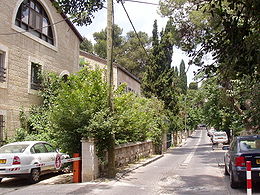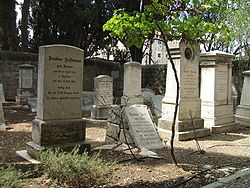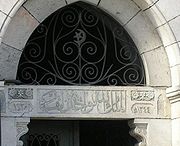
German Colony of Jerusalem
Encyclopedia

Templers (religious believers)
Templers are members of the Temple Society , a German Protestant sect with roots in the Pietist movement of the Lutheran Church. The Templers were expelled from the church in 1858 because of their millennial beliefs. Their aim was to realize the apocalyptic visions of the prophets of Israel in the...
. Today the Moshava
Moshava
A moshava , plural: Moshavot is a form of rural settlement in Israel.In a moshava, as opposed to communal settlements like the kibbutz and the moshav, all the land and property are privately-owned. The first moshavot, described as "colonies" in professional literature, were established by...
, as it is popularly known, is an upscale neighborhood bisected by Emek Refaim
Emek Refaim
Emek Refaim is the main street of the German Colony, a neighborhood in Jerusalem, Israel. It takes its name from the biblical Valley of Rephaim which began its descent from Jerusalem here.-Etymology:...
Street, an avenue lined with trendy shops, restaurants and cafes.
Biblical era
Emek Refaim (Valley of Refaim) is mentioned in the Book of Joshua and 2 Samuel. The name is derived from a legendary race of giants who lived in this region in biblical times.Templer settlement

Haifa
Haifa is the largest city in northern Israel, and the third-largest city in the country, with a population of over 268,000. Another 300,000 people live in towns directly adjacent to the city including the cities of the Krayot, as well as, Tirat Carmel, Daliyat al-Karmel and Nesher...
and Jaffa
Jaffa
Jaffa is an ancient port city believed to be one of the oldest in the world. Jaffa was incorporated with Tel Aviv creating the city of Tel Aviv-Yafo, Israel. Jaffa is famous for its association with the biblical story of the prophet Jonah.-Etymology:...
, members of the Templer
Templers (religious believers)
Templers are members of the Temple Society , a German Protestant sect with roots in the Pietist movement of the Lutheran Church. The Templers were expelled from the church in 1858 because of their millennial beliefs. Their aim was to realize the apocalyptic visions of the prophets of Israel in the...
sect from Württemberg
Württemberg
Württemberg , formerly known as Wirtemberg or Wurtemberg, is an area and a former state in southwestern Germany, including parts of the regions Swabia and Franconia....
, Germany, settled on a large tract of land in the Refaim Valley, southwest of the Old City of Jerusalem. The land was purchased by one of the colonists, Matthaus Frank, from the Arab
Arab
Arab people, also known as Arabs , are a panethnicity primarily living in the Arab world, which is located in Western Asia and North Africa. They are identified as such on one or more of genealogical, linguistic, or cultural grounds, with tribal affiliations, and intra-tribal relationships playing...
s of Beit Safafa
Beit Safafa
Beit Safafa is an Arab neighborhood in south Jerusalem midway between the Jerusalem neighborhoods of Patt and Gilo, on the outskirts of Bethlehem. Beit Safafa had a population of 5,463 in 2000. It covers an area of 1,577 dunams.-History:...
. The Templers were Christians who broke away from the Protestant church and encouraged their members to settle in the Holy Land to prepare for Messianic salvation. They built their homes in the style to which they were accustomed in Germany - farmhouses of one or two stories, with slanting tiled roofs and shuttered windows, but using local materials such as Jerusalem stone
Jerusalem stone
Jerusalem stone is a name applied to various types of pale limestone, dolomite and dolomitic limestone, common in and around Jerusalem that have been used in building since ancient times...
instead of wood and bricks. The colonists engaged in agriculture and traditional trades such as carpentry and blacksmith
Blacksmith
A blacksmith is a person who creates objects from wrought iron or steel by forging the metal; that is, by using tools to hammer, bend, and cut...
ing. Their homes ran along two parallel streets that would become Emek Refaim and Bethlehem Road. The British Mandatory government deported the German Templers during World War II
World War II
World War II, or the Second World War , was a global conflict lasting from 1939 to 1945, involving most of the world's nations—including all of the great powers—eventually forming two opposing military alliances: the Allies and the Axis...
. As Germans, they were considered enemy citizens, all the more so because they made no effort to disguise their Nazi sympathies. Some of them resettled in Australia.
Palestinian Arab settlement
As the neighborhood expanded south along the valley, many of the lots were purchased by well-to-do Christian Arab families attracted by its location between the road to BethlehemHighway 60 (Israel)
Highway 60 is a north-south intercity road in Israel and the West Bank that stretches from Beersheba to Nazareth.-Route:The route is also known as the "Route of the Patriarchs" since it follows the path of the ancient highway that runs along the length of the central watershed, and which...
and the developing neighborhoods of Katamon, Talbiya
Talbiya
Talbiya or Talbiyeh , officially Komemiyut, is an upscale neighborhood in Jerusalem, Israel, located between Rehavia and Katamon. It was built in the 1920s and 1930s on land purchased from the Greek Patriarchate...
, and Baka
Baka, Jerusalem
Baka , , is a neighborhood in southern Jerusalem, Israel. The neighborhood is bounded by Talpiot to the south, Mekor Chaim to the west, the Greek Colony and German Colony to the northwest, and Abu Tor to the east.-History:...
, which were populated by some of Jerusalem's wealthiest Arabs.
After Israeli independence
The Arab residents of Katamon fled in 1948, in the wake of fierce battles for control of the area during the Israeli War of Independence. The abandoned homes in the German Colony and other parts of Katamon were used to house new immigrants. Since the end of the 20th century, the neighborhood has undergone a process of gentrificationGentrification
Gentrification and urban gentrification refer to the changes that result when wealthier people acquire or rent property in low income and working class communities. Urban gentrification is associated with movement. Consequent to gentrification, the average income increases and average family size...
. Efforts are being made to restore old landmark buildings and incorporate some of their architectural features, such as arched windows and tiled roofs, in new construction. Numerous cafes, bars, restaurants, and boutiques have opened in the neighborhood, and many affluent families have moved there, pushing up the price of real estate. The German Colony has a large English-speaking population, with the English speaking community comprising both families and singles, permanent immigrants and visitors. The neighborhood is home to the Smadar Theater, Jerusalem's arthouse cinema and a perennial gathering place for the artisterati.
Architecture

Art Deco
Art deco , or deco, is an eclectic artistic and design style that began in Paris in the 1920s and flourished internationally throughout the 1930s, into the World War II era. The style influenced all areas of design, including architecture and interior design, industrial design, fashion and...
from the Mandatory period, within close proximity. An example of British architecture is the Scottish Hospice and St Andrew's Church, built in 1927, decorated with local Armenian tilework. Some of the Templer homes have biblical inscriptions in German on their lintels, in Fraktur script.
Street names
The side streets of the German Colony are named for Gentile supporters of Zionism and the Jewish people. Apart from the French author Emile ZolaÉmile Zola
Émile François Zola was a French writer, the most important exemplar of the literary school of naturalism and an important contributor to the development of theatrical naturalism...
, Czech president Tomas Masaryk
Tomáš Masaryk
Tomáš Garrigue Masaryk , sometimes called Thomas Masaryk in English, was an Austro-Hungarian and Czechoslovak politician, sociologist and philosopher, who as an eager advocate of Czechoslovak independence during World War I became the founder and first President of Czechoslovakia, also was...
, and South African prime minister Jan Smuts
Jan Smuts
Jan Christiaan Smuts, OM, CH, ED, KC, FRS, PC was a prominent South African and British Commonwealth statesman, military leader and philosopher. In addition to holding various cabinet posts, he served as Prime Minister of the Union of South Africa from 1919 until 1924 and from 1939 until 1948...
, many of the streets are named for Britons: Liberal Prime Minister David Lloyd George
David Lloyd George
David Lloyd George, 1st Earl Lloyd-George of Dwyfor OM, PC was a British Liberal politician and statesman...
, British Labour Party leader Josiah Wedgewood, Colonel John Henry Patterson
John Henry Patterson
John Henry Patterson may refer to:* John Henry Patterson , Anglo-Irish soldier who wrote The Man-Eaters of Tsavo which was made into the film The Ghost and the Darkness in 1996...
, commander of the Jewish Legion
Jewish Legion
The Jewish Legion was the name for five battalions of Jewish volunteers established as the British Army's 38th through 42nd Battalions of the Royal Fusiliers...
in World War I
World War I
World War I , which was predominantly called the World War or the Great War from its occurrence until 1939, and the First World War or World War I thereafter, was a major war centred in Europe that began on 28 July 1914 and lasted until 11 November 1918...
and the pro-Zionist British general Wyndham Deedes
Wyndham Deedes
Sir Wyndham Henry Deedes CMG DSO was a British Brigadier General and was also the Chief secretary to the British High Commissioner of the British Mandate of Palestine.- Early life :Deedes was born in 1893 in Kent, England...
.
Landmarks

- Gemeindehaus, communal hall - 1 Emek Refaim Street
- Friedrich Eberle House - 10 Emek Refaim Street
- Matthaus Frank House - 6 Emek Refaim Street
- Pension Schmidt
- Lev Smadar Theater - formerly Orient Cinema, Lloyd George Street
- Convent of Borromean Sisters - 12 Lloyd George Street
- Templer Cemetery - 39 Emek Refaim Street
- Imberger House
- Shalom Hartman InstituteShalom Hartman InstituteShalom Hartman Institute is a Jewish research and education institute based in Jerusalem, Israel, that offers pluralistic Jewish thought and education to scholars, rabbis, educators, and Jewish community leaders in Israel and North America...
- 11 Gedalyahu Alon Street
Development plans
For years, developers have been trying to build up the area at the northern entrance to the neighborhood, overlooking Liberty Bell Park. Mass protests in the early 1970s failed to halt the construction of a high-rise apartment building, known as the Omariya compound. In the wake of protests by environmentalists and neighborhood activists, the plans have been altered, and the height of a planned 14-story Four Seasons HotelFour Seasons Hotels
Four Seasons Hotels, Inc. is a Canadian-based international ultra-luxury, five-star hotel management company. Travel + Leisure magazine and Zagat Survey rank the hotel chain's 84 properties among the top luxury hotels worldwide...
has been cut to seven stories.
Israeli-Arab conflict
During the Second Intifada, in September, 2003, a Palestinian suicide bomber blew himself up outside a cafe on Emek Refaim Street, killing seven people.Notable residents
- Ehud OlmertEhud OlmertEhud Olmert is an Israeli politician and lawyer. He served as Prime Minister of Israel from 2006 to 2009, as a Cabinet Minister from 1988 to 1992 and from 2003 to 2006, and as Mayor of Jerusalem from 1993 to 2003....
, former Prime Minister of Israel - Batya GurBatya GurBatya Gur was an Israeli writer. Her specialty was detective fiction.-Biography:Batya Gur was born in Tel Aviv in 1947 to parents who survived the Holocaust. She earned a master's degree in Hebrew literature from the Hebrew University of Jerusalem. Before writing her first detective novel at the...
, Israeli novelist and literary critic - Charles WintersCharles WintersCharles "Charlie" Thompson Winters was an American businessman who volunteered during the 1948 Arab–Israeli War. He was imprisoned for 18 months for helping smuggle three B-17 Flying Fortress heavy bombers to Israel in the late 1940s, but pardoned posthumously by President George W...
, American businessman and Zionist

